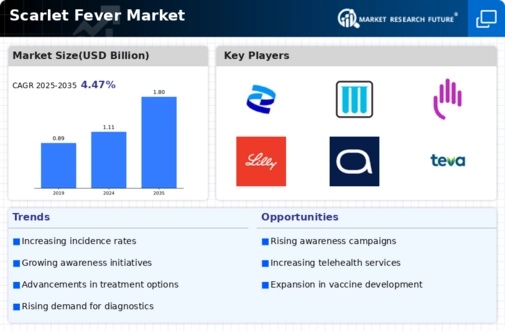Enhanced Diagnostic Capabilities
The Scarlet Fever Market is witnessing advancements in diagnostic technologies, which are crucial for early detection and treatment of the disease. Innovations such as rapid antigen tests and molecular diagnostics have significantly improved the accuracy and speed of diagnosis. For instance, the introduction of point-of-care testing has reduced the time required to confirm a Scarlet Fever Market diagnosis from days to mere hours. This enhancement in diagnostic capabilities is likely to increase the number of diagnosed cases, thereby expanding the market. Furthermore, as healthcare systems adopt these technologies, the Scarlet Fever Market is expected to see a surge in demand for diagnostic kits and related services, ultimately leading to improved patient management and outcomes.
Rising Incidence of Scarlet Fever
The Scarlet Fever Market is experiencing a notable increase in reported cases, particularly among children aged 5 to 15. This rise can be attributed to various factors, including changes in environmental conditions and the resurgence of Streptococcus pyogenes, the bacteria responsible for the disease. Recent data indicates that the incidence rate has increased by approximately 20 percent over the past five years in certain regions. This trend is likely to drive demand for diagnostic tools and treatment options, as healthcare providers seek to manage and mitigate outbreaks effectively. Consequently, the growing number of cases is expected to stimulate investments in the Scarlet Fever Market, as stakeholders aim to enhance their product offerings and improve patient outcomes.
Rising Awareness of Infectious Diseases
The Scarlet Fever Market is experiencing a surge in awareness regarding infectious diseases, particularly among parents and educators. This heightened awareness is largely due to increased media coverage and public health campaigns aimed at educating communities about the symptoms and risks associated with Scarlet Fever Market. As individuals become more informed, they are more likely to seek medical advice and treatment, leading to an uptick in diagnosed cases. This trend is anticipated to drive growth in the Scarlet Fever Market, as healthcare providers respond to the demand for effective treatment options and educational resources. Furthermore, the collaboration between public health organizations and healthcare providers is likely to enhance the overall response to Scarlet Fever Market outbreaks.
Growing Investment in Pediatric Healthcare
The Scarlet Fever Market is benefiting from increased investment in pediatric healthcare, driven by a heightened focus on child health and well-being. Governments and private entities are allocating more resources to combat infectious diseases affecting children, including Scarlet Fever Market. This trend is reflected in the establishment of specialized clinics and the development of targeted treatment protocols. As a result, the market for Scarlet Fever Market is likely to expand, with more healthcare providers offering comprehensive care solutions. Additionally, the emphasis on preventive measures and education about Scarlet Fever Market is expected to further enhance the market landscape, as parents and caregivers become more proactive in seeking medical attention for their children.
Technological Advancements in Treatment Options
The Scarlet Fever Market is poised for growth due to ongoing technological advancements in treatment options. Recent developments in antibiotic therapies and supportive care have improved patient outcomes significantly. For example, the introduction of new formulations of penicillin and alternative antibiotics has enhanced treatment efficacy, reducing recovery times and complications. Additionally, the integration of telemedicine into treatment protocols allows for better patient monitoring and follow-up care, which is particularly beneficial in managing Scarlet Fever Market cases. As these innovations continue to evolve, the Scarlet Fever Market is expected to expand, with healthcare providers increasingly adopting these advanced treatment modalities to improve patient care and reduce the burden of the disease.

















Leave a Comment